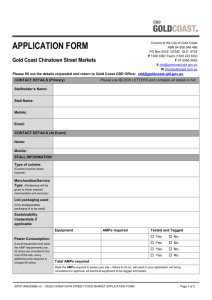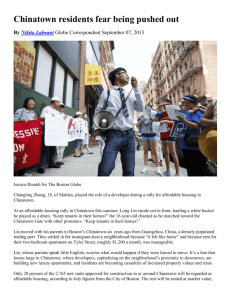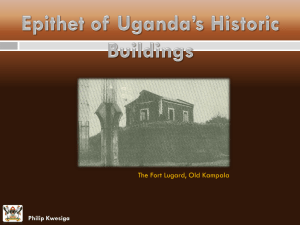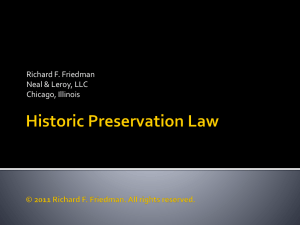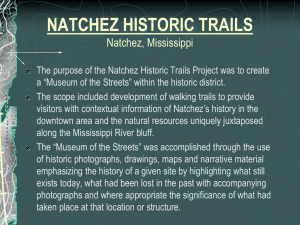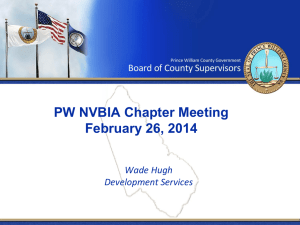Cultural and Historical Preservation
advertisement
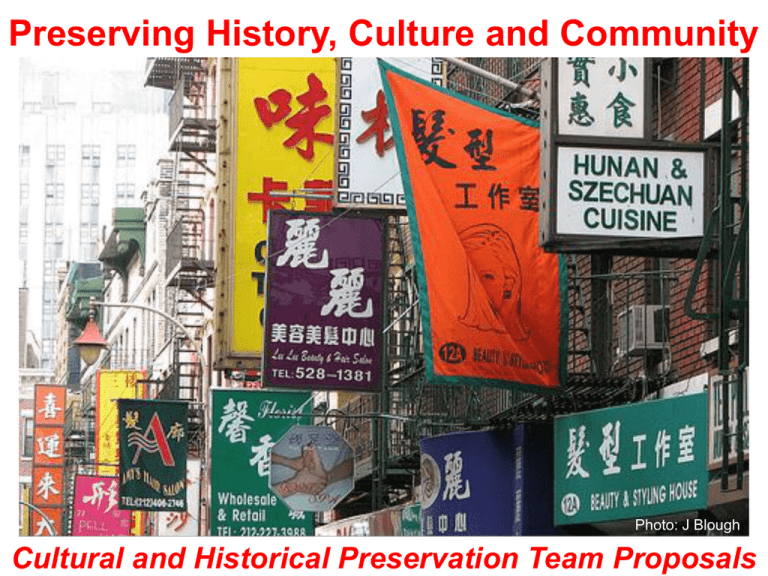
Preserving History, Culture and Community Photo: J Blough Cultural and Historical Preservation Team Proposals The Bowery ca. 1750, site of Domingo’s farm at the left, Catelina’s at the right. The neighborhood we know as Chinatown began in 1643. Two farm lots extending from Baxter Street past Chatham Square, on either side of a double wagon road -today’s Bowery -- were given to Domingo Antony and Catelina, widow of Jochem Antony, free Africans. The neighborhood soon became New York’s first African village, the Bouwerij Village. In the 19th century, it was known as Five Points, the home of German, Irish, Italian and Jewish immigrants. To house and rent the immigrant refugees, landowners created the first multiple dwelling: the tenement. These soon became the tallest buildings in New York, the skyscrapers of the day; only church steeples were taller. Five Points, ca. 1850 - Oliver Street - Before tenements, New Yorkers lived in single-family row houses. At first, tenements were simple like most townhouses and early American architecture. - 65 Mott Street oldest tenement in New York 7 stories, c.1820 During the 1860’s and ‘70’s, tenements followed the English fashion for Italianate ornaments. -Eldridge Street ca. 1865 By the 1880’s, tenements were elaborate and ornamented, ranging in style from the classical, Palladian and distinguished - 66 Bayard - to the fanciful and unrestrained, covered with terra cotta and multiple architectural materials: stone, concrete, terra cotta, molded and delicately tinted brick. -162 Henry Street Renaissance Revival Herter Bros., Architect -86 Madison Street Eclectic Rundbogenstil …frequently with Italian Renaissance models, but sometimes with Nordic, Wagnerian themes or imitating the Parisian Academie des Beaux Arts - Eldridge Street at Division ca. 1900 During the ‘City Beautiful Movement’ -- and after a sweeping housing reform law in 1901 -- tenements expanded in scale and grandeur. - 253 Grand Street at Chrystie Beaux Arts - Art Nouveau New Law tenement New S. Vill Most of CD1 and CD2 are protected and preserved by special zoning or landmark districting. Here are the special zonings (the four zones in CD3 are projected 2nd Avenue subway stations, not preservation zones) and historic districts in white the South Village District proposal (black outline) has been partially designated New South Village District Community Districts 1 and 2 are almost entirely protected with landmarking and special zoning. CD2 New South Village Hist Dist Second Avenue subway Second Avenue subway CD1 Second Avenue subway CD3 Community District 3 the Lower East Side has only one preservation area, Stuyvesant Street Over the last two years, the Culture & Preservation Team has been surveying Chinatown buildings and streetscapes Photo: Amy Chin The Team defined Chinatown as streets with 90% Chinese storefronts excluded We walked through every street on the map and catalogued every building. Here’s an example of our spreadsheet from our walk-through This is one sheet from our Chrystie Street walk-through For each address, we recorded: the number of stories the condition of the building estimated date of construction kind of storefront business whether the building would not contribute to a historic district and a detailed description of the façade. And whether the building merits individual landmarking We divided this “greater Chinatown” into four areas: Five Points Chinatown Two Bridges Chinatown expansion Lower East Side Chinatown expansion Little Italy Chinatown expansion Little Italy Lower East Side Five Points Two Bridges Bowery East CAPZBAN Also, the Team includes the CAPZ-Bowery Alliance of Neighbors preservation plan for the east side of the Bowery. Lower East Side Five Points Two Bridges (The west side of Bowery is already protected in the Special Little Italy District and the NoHo Historic Districts) We have no proposals regarding Little Italy For the other four areas we propose these preservation tools: contextual zoning special purpose zoning landmark districting Historic District And Special Purpose Zoning Excluded from landmark district Historic District and Special Purpose Zoning The Team proposes that, to preserve the history and character of Chinatown and its community, all four districts be designated as one or more New York Historic District, except Division Street and East Broadway. There are at least three distinct historic districts, Five Points, the Lower East Side Chinatown and Two Bridges. CB3 CD3 CD2 The Bowery LES Chinatown 5 Points Two Bridges CD3 The Team also proposes that all three districts be designated Special Purpose Districts by the City Planning Commission to encourage local community businesses and preserve the local character and vitality. The Team proposes the following principles: Aspects to preserve: Scale -- heights (height caps) Scale -- bulk (FAR limits) Lots -- (prohibit combining storefront lots or big box chains) Street patterns (e.g., Doyers' bend) Masonry (brick) Contextual fenestration Contextual projecting decorative cornices Contextual window surrounds (often stone) Contextual entryways (often stone) Contextual decorative façades (stone, brick, terra cotta) Fire escapes Early 20th century signs in Chinese characters Contemporary projecting signs We identified several consequences of a Landmarking: Property rights (air rights/development rights) are preserved for the owners Air rights can be transferred further to violate the context nearby Alterations require LPC permission, an inconvenience for ground floor commerce Street use and commercial use are not restricted Buildings are positively protected The context is positively protected (new buildings in a landmark district must pass through LPC) Protections inconvenience developers New signs are usually required to conform with either current styles or historic styles New repairs or renovations may have to conform to historic models LPC does not require renovation or restoration LPC offers financial assistance for some repairs and restoration Landmarks Conservancy offers financial assistance for maintenance Also, we identified several consequences of a Special Zoning: Property rights (air rights/development rights) may be lost to owners Air rights are severely restricted or obviated, protecting the context Height caps cannot be modulated to buildings that are lower than the 85% compliance DCP usually requires Street use, commercial use, future development all may be restricted Alterations may require only at most DoB permission Development disincentive helps to protect buildings (though not positively protected) Disincentive to develop helps to protect the context (though not positively protected) Protections inconvenience developers. Finally, we considered their conjunction: Landmarked air rights may be lost Aggregation of air rights may be prevented Buildings are positively protected Streets and uses positively protected If one application (landmarks or special zoning) is rejected, the other may still succeed -- so applying both should be considered and considered as if they might be approved alone (e.g., with special consideration for what happens under each tactic). To facilitate both these preservation tools, the Team proposes that a Historic Trust Fund be created for Chinatown, administered by a Chinatown Conservancy. A Chinatown Conservancy and Historic Trust Fund would assist owners and tenants of historic properties with compliance issues. This entity could be financed with assessments on new construction and development in the planning area. The City also uses contextual rezonings - zones that preserve the context of a neighborhood by limiting bulk and height and the street wall of new buildings. So the Cultural and Preservation Team proposes contextual zonings for each of the three areas. For Five Points, we propose a C4-4A rezoning C4-4A: FAR 4 80 foot height caps • • • • Current zone: C6-1 FAR 6 commercial FAR 6.5 community facility FAR 3.44 residential The current zone encourages out-of-scale hotel development at the expense of housing, and threatens eviction for demolitions and redevelopment. Current zoning does not allow large residential buildings, but does allow large hotels. So current zoning encourages many more big hotels, like Hotel Mulberry --replacing residents: QuickTime™ and a TIFF (Uncompressed) decompressor are needed to see this picture. QuickTime™ and a TIFF (Uncompressed) decompressor are needed to see this picture. QuickTime™ and a TIFF (Uncompressed) decompressor are needed to see this picture. QuickTime™ and a TIFF (Uncompressed) decompressor are needed to see this picture. Current zoning allows even larger dormitories The East Village/LES rezoning prevents any further community destruction from out-of-scale dormitories in the residential blocks of the Lower East Side. Delancey Street Today, Five Points buildings still have an average FAR of only 4.2, and 90% of the buildings are lower than 75 feet tall. The Team proposes that Five Points should be rezoned exactly as the Lower East Side was rezoned, to prevent out-of-scale hotels and dormitories. In Five Points-Chinatown, identical rezoning from C6-1 to C4-4A will prevent out-of-scale development and will allow underbuilt structures to be expanded or redeveloped for housing. For Two Bridges Chinatown, the Team proposes an R8B zone for residential Henry, Madison and Monroe; C4-4A on commercial Division and East Broadway C4-4A: FAR 4 80 foot height caps C4-4A R8B R8B: FAR 4 75 foot height caps Currently, Two Bridges-Chinatown is divided into three zones: • Division and East Broadway to Pike: C6-1G commercial FAR 6 residential FAR 3.44 community facility 6.5 Pike to Rutgers, Division to East Broadway: C6-2 no height limits Commercial FAR 6 Community facility FAR 6.5 Henry, Madison, Monroe: R7-2 Residential up to 6.02 residential FAR 3.44 No height limits community facility FAR 6.5 no height limits C6-2 C6-1G R7-2 R7-2 Most buildings in Two Bridges Chinatown are less than 70 feet tall, FAR 3.5, yet the current zoning allows FAR 6 for hotels, 6.5 FAR for dormitories, and unlimited heights. Madison Street at Pike, 12 stories The C6-1G zone carries all the dangers of out-of-scale hotel development as C6-1. Rezoning to C4-4A / R8B would be consistent with the Lower East Side rezoning and will protect the neighborhood from out-of-scale hotel development while allow for new housing in soft sites. C4-4A R8B For the Lower East Side Chinatown area, the Team proposes a C4-4A zone, exactly the same zone as the recent LES protective rezoning. CB3 CD3 CD2 LES/ Chinatown CD3 The Lower East Side area of Chinatown is divided in 7 zones. Part of the LES area was already rezoned as C4-4A to protect the neighborhood from out-of-scale hotel development. The areas that were not rezoned have no protection unless they are rezoned now Tenement Museum Historic District (CB3 approved) LES Chinatown The Team proposes to extend the recent LES rezoning to the LES area of Chinatown so that out-of-scale hotels do not move into the Chinatown neighborhood displacing the local community. In the recent LES rezoning, the City Planning Commission upzoned Chrystie Street to C6-3A, which allows FAR 7.52 and 145' heights. During the rezoning process, CB3 passed a resolution objecting to the upzoning, which they felt was excessive. At Community Board 3, it was suggested that a proposal to rezone Chrystie Street would give the community an opportunity to revisit that upzoning. Bowery East CAPZBAN Lower East Side Five Points Two Bridges The East Bowery Plan The current zoning on east Bowery is C6-1 and C6-1G, with no height caps. The East Bowery Plan does not propose any change in the zoning designation, except adding height caps of at 85 feet, or eight stories, conforming to the west side of the Bowery. The Bowery Plan also proposes protections for buildings of special significance. East Bowery Preservation Plan Goals * Preserve low-rise historic context of the entire Bowery * Preserve Bowery’s low-rise context in relation to adjacent historic Chinatown, Little Italy, NoHo, East Village, and Lower East Side * Prevent out-of-scale, out-of-context developments * Protect low-rise buildings of special significance * Allow controlled, responsible development, including community facilities, while maintaining low-rise character * Promote retention of mixed socio-economic populations, affordable housing, social services & artists’ live/work spaces * Protect small businesses, including long-established lighting, jewelry, and restaurant supply districts These proposals were conceived as goals and principles, not demands. They are intended to offer a guide -- if the CWG endorses them -- for a planning consultant. The narrow scope of the boundaries were limited by the CWG decision to plan for “Chinatown and surrounding neighborhoods” and the participation of local constituencies. Photo: Amy Chin Addendum Three remaining unresolved comments from the August presentation: 1. Review Canal Street west of Baxter and consider keeping it in the Chinatown map. 2. Consider the new city plan to require individual permits for hotels. 3. Work with the Economic Team to locate affordable housing bonus areas and consider their scale and context.
